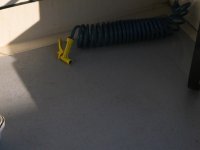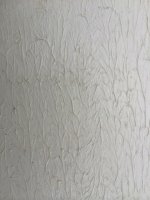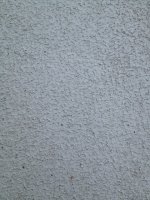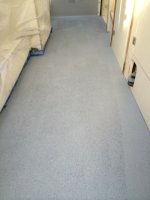John S":28k377g1 said:
Does anyone out there know how it was done at the factory back in the day that hasn't chimed in yet.
I don't specifically know for sure how it was done by any C-Dory builder, but I can say how it's often done with a molded fiberglass boat.
In a nutshell, the boat is built from the outside in, in female molds. So start by picturing the deck mold (basically everything from the gunwales up) upside down in the workshop.
Into that upside down deck mold would be sprayed a mold-release of some type (think of greasing a pan before cooking something so that it does not stick to the pan afterward). After that, gelcoat (polyester resin + pigment) would be sprayed in. That will make up both the non-skid and the overall shiny boat finish. If the non-skid is a different color than the rest of the deck, it would be sprayed in first.
Next, resin and reinforcements ("cloth") are used to build up the boat's deck. I don't know how C-Dorys were/are made, but this can be done in different ways (by hand, vacuum bag, etc.)
If parts of the deck are to be cored (which is common), then after some number of layers the core is laid down, and then more layers of fiberglass are added up to the final thickness.
Gelcoat may be sprayed over the inside (although this just depends on what the inside of a particular boat will be finished like - some boats have a gelcoat finish, some are painted, and some are left bare and then the fiberglass covered by some decorative material (wood, vinyl, etc.). My guess would be that the "white with lines or speckles" finish on the inside of a C-Dory is gelcoat, but I don't know for sure.
If the inside of the deck/cabin is gelcoated, you can probably notice that the shine/finish of it is a lot different than the outside of the boat. That's because the outside layer was sprayed into a mold, whereas the inside was "painted on" as a last layer. It's a lot easier to get a nice, shiny perfect gelcoat layer the first way. With non-skid patterns that are like diamonds (vs. sandy), the "negative" of the non-skid pattern would be present in the mold itself.
For me, if I were going to repair/replace a non-skid area, the first decision would be whether to repair or replace. For a small area on a boat where most of the non-skid was still in great condition, I might try to duplicate the non-skid (you can't re-spray it in a mold at this point, but there are various ways, including the molds made by people like Gibco Flex-Mold*).
For a boat with non-skid that was not in overall good condition, I would probably sand/grind the non-skid off completely and start over (from a flat deck). If I were starting over, I would probably use something like a two-part LPU paint (Awlgrip being one example), or maybe a two-part Acrylic (Awlcraft and others). You can use sand, walnuts, etc. for the actual grip; or there are specially made "beads" that are supposed to be a bit less "sharp" (may resist wearing through the top of the paint better). Interlux makes one. Gelcoat can possibly be harder to control in a "surface" application (vs. spraying into a mold). Of course it can be done; I'm just saying it's not as easy as the original mold spraying.
These days, I would say that a two-part linear LPU is being used as the equivalent of gelcoat on some/many boats. That is, they are being painted straight from the builder vs. gelcoated. But it's really more of a "coating" than "simply" a paint. That's not to say that there's anything wrong with gelcoat - especially when sprayed into a mold - as it's a great finish. Just that paints/coatings can have a place as well.
One last note is that epoxy generally does not have appropriate UV resistance (can be improved with pigment, but still not complete), so if it's used it should generally have a paint or varnish topcoat to protect it and keep it from breaking down.
PS: Here is a link that discusses the use of Gibco Flex-Mold. If they don't have the exact pattern of your deck, you can sometimes use a very similar one and get decent results (depending on your expectations).
http://www.westsystem.com/ss/assets/Upl ... onskid.pdf




